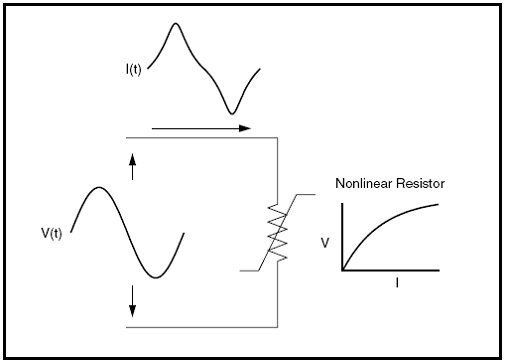What is Harmonics?
Harmonics are sinusoidal voltages or currents having frequencies that are integer multiples of the frequency at which the supply system is designed to operate (termed the fundamental frequency; usually 50 or
60 Hz). Harmonic frequencies are produced by the action of non-linear loads such as rectifiers, discharge lighting, or saturated electric machines.
Is there any Guideline/Standard available for Harmonics?
IEEE Standard 519-2014 provides guidelines for harmonic current and voltage distortion levels on distribution and transmission circuits.
How Harmonics are described?
Harmonic distortion levels are described by the complete harmonic spectrum with magnitudes and phase angles of each individual harmonic component. It is also common to use a single quantity, the total
harmonic distortion (THD), as a measure of the effective value of harmonic distortion. Figure given below, illustrates the waveform and harmonic spectrum for a typical variable frequency drive (VFD) input
current.

Current distortion levels can be characterized by a THD value, as previously described, but this can often be misleading. For example, many variable frequency drive (VFD) will exhibit high THD values for the
input current when they are operating at very light loads. This is not necessarily a significant concern because the magnitude of harmonic current is low, even though its relative distortion is high. To
handle this concern for characterizing harmonic currents in a consistent fashion, another term is defined, the total demand distortion (TDD). This term is the same as the total harmonic distortion except that
the distortion is expressed as a percent of some rated load current rather than as a percent of the fundamental current magnitude at the instant of measurement.
What makes the Harmonics to flow in the Power System?
Harmonic distortion is caused by nonlinear devices in the power system. A nonlinear device is one in which the current is not proportional to the applied voltage. Figure below illustrates this concept by the
case of a sinusoidal voltage applied to a simple nonlinear resistor in which the voltage and current vary according to the curve shown. While the applied voltage is perfectly sinusoidal, the resulting current
is distorted. Increasing the voltage by a few percent may cause the current to double and take on a different wave shape. This is the source of most harmonic distortion in a power system.

What are the loads responsible for Harmonics Generation?
The nonlinear loads like, Variable Frequency Drives, Induction Furnaces, Saturable Reactors, Electronics Ballast, UPS, Thyristoried Power Control Devices, Switch Mode Power Supplies, Computers, Single Phase
Rectifiers, AC Regulators and Cyclo-converters to name a few.
Are Harmonics causing any damage to system?
Yes, the adverse effects of harmonics are, Frequent capacitor failures, Nuisance tripping of Circuit Breakers, Electronics card failures, Motor overheating, Power loss in cables, Higher power loss in
transformers, Transformer de-rating, Nuisance fuse blowing, Misfiring of Thyristor/static devices, Voltage flickering and many more...
How Harmonics can be controlled?
There are two main strategies to control harmonics
- a. Before Generation: 12/18/Multi pulse rectifiers, Harmonics Mitigation transformers, Active Front-end Converter, Line reactors
- b. After Generation: Passive Harmonics Filters, Active Harmonics Filters
How Active Filters are better than Passive Filters?
As the name suggests, passive filters are made up of passive devices (capacitors and inductors) and it does not have capability to sense the real time condition. Whereas the Active Harmonics Filters are made
of active and programmable devices. It monitors the harmonics in the system continuously and cancels the harmonics effectively without any negative impact on the system.
Why Passive Filters are not able to give guaranteed performance?
Passive Harmonic Filters, if not designed according to the system requirements are not able to perform due to mismatching. Also passive filters performance is very prone to some of the variations, like load
variations, frequency variations, system modifications, capacitors aging, inductor saturation etc...
Also, once designed and installed, the Passive Harmonic Filters will not be suitable for other harmonics order. For example, 5th order harmonics filter will not work well with 11th harmonics order. All these
disadvantages are not present in Active Harmonics Filters.
Can Active Harmonics Filter be connected with existing capacitors?
Yes, Active Harmonic Filters (AHF) can be connected with existing capacitors banks, but care has to be taken that the capacitors should be connected with de-tuned reactors.
Can AHF improve the power factor?
Yes, AHF improves the power factor by reducing the distortion level of the Harmonics. Also Amtech make Active Harmonic Filter offers reactive power compensation mode, which if enabled, improves the power
factor by generating reactive power at fundamental frequency.
How capacity addition is made in AHF?
AHF is an active device. It will compensate the harmonics within limits of its rating. If harmonics are increased, due to any reason, in future, the additional AHF can be connected in parallel to existing
AHF.
What are the ill effects of Harmonics?
Harmonics effects on power system can be summarized as increased losses, equipment heating and loss of life, and interference with protection, control and communication circuits as well as customer loads.
What are the solutions to control the harmonics in power system?
To name a few, Passive Filters, Active Filters and Hybrid Filters (combination of Active and Passive Filter) of suitable rating and design can be employed to control the harmonics. However, any solution
should be installed only after thorough study of system, otherwise it may lead to rise of problems.
Which are the standards on Harmonic?
The limit of allowable voltage and current harmonic distortions are set by standards like IEEE, IEC, EN etc.
Why AMTECH for Harmonic Solution?
AMTECH is a pioneer name in the field of power electronics and a leading manufacturer of Variable Frequency Drives. We understand the subject of harmonics very well. We have in depth knowledge of harmonics,
gained through years of experience. AMTECH provides comprehensive solutions starting from power quality study to implementation of filters.

